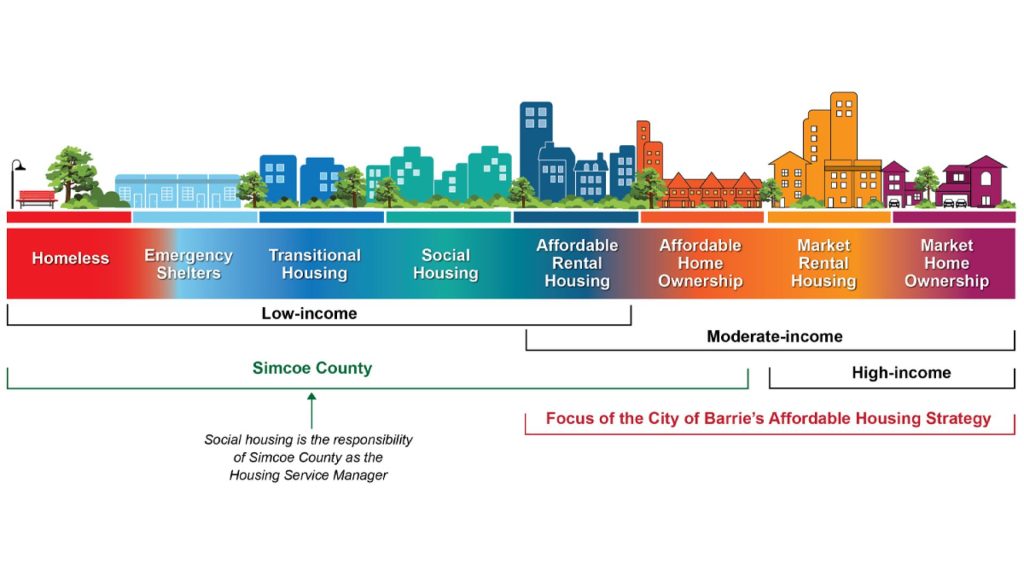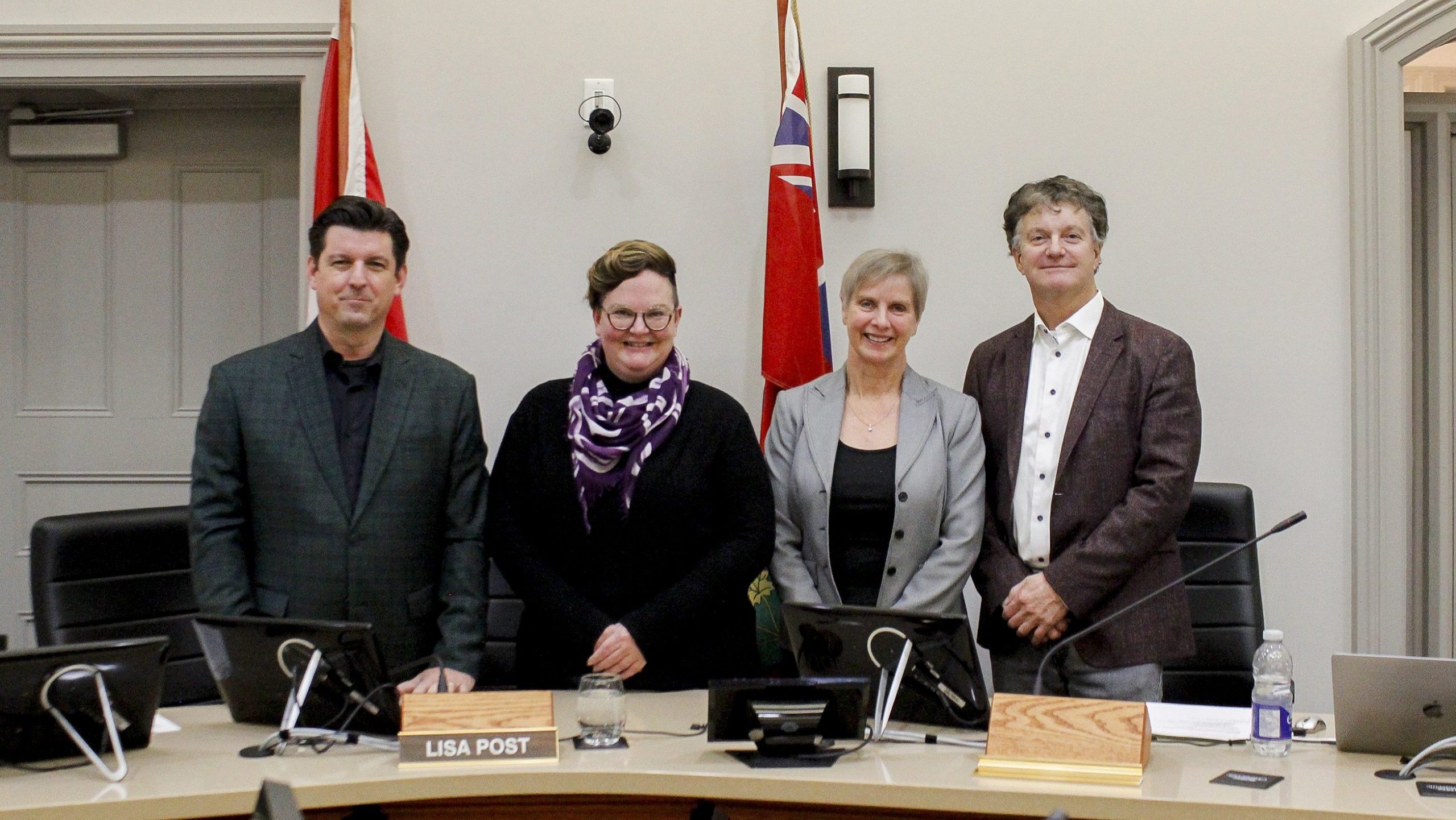Housing takes many forms along a continuum, from temporary emergency shelter to market home ownership:

Affordable housing is one component of a healthy housing stock
Affordable housing (rental and ownership) is one of the components that make up a healthy housing stock along with emergency shelters, transitional housing, social housing and market housing.
Housing is a ladder. Higher up, housing is more expensive, but also more spacious, newer, and more secure. Lower down, housing is less expensive, but more crowded, older, less secure, and in the worst cases, in poor condition.
It’s all connected, because people can move down the ladder. Scarcity higher up the ladder pushes people downward. When you block new market-rate housing, the people who would have lived there don’t just vanish: they’ll find somewhere else to live, further down the ladder.
This makes housing more expensive at each lower rung of the ladder, putting immense pressure on people closer to the bottom. They’re forced to move away, to crowd into terrible housing, or worst of all, end up homeless.
The housing ladder, Russil Wvong
In Ontario, municipalities are responsible for providing an appropriate range and mix of housing options.
For example, Barrie’s Affordable Housing Strategy focuses on addressing the supply of housing in the moderate-income segment of the continuum, from Affordable Rental Housing to Market Home Ownership, while the County of Simcoe – the designated Service Manager for Barrie under the Housing Services Act, 2011 – is responsible for planning, funding and managing social housing programs and homelessness services:
Affordable housing is for those who aren’t earning enough to afford market housing, but too much to be eligible for government assistance and the social housing waitlist.
However, homeownership is not the ultimate goal for everyone as some households choose to rent due to their planned length of stay in an area, proximity to work, changes in household composition and other reasons. Communities need to include a broad range of housing options, forms and tenures, in order to meet residents’ diverse and changing socio-economic status at each stage of their lives.

Definitions used in Canada
Income-based definition
In Canada, affordable housing is defined as shelter that costs less than 30% of gross (before-tax) household income for low-to-moderate income households.
Capping the cost of shelter at 30% of gross income ensures that the household has enough money left over for other necessary costs of living such as food and transportation and others. This way, housing expenses fit into a person’s budget regardless of what level of income they have and it takes up a similar percentage of their gross income compared to the average Canadian – ie. putting the affordable into ‘Affordable Housing’.
In practice, ‘shelter’ typically refers to the cost of the rent or mortgage payments and property taxes, but some definitions also include electricity, fuel, water and other municipal services.
For example, Statistics Canada’s “shelter cost to income ratio” metric is determined by dividing the average monthly shelter cost (includes condo fees, electricity, heat, water and other municipal services on top of rent/mortgage) by the average monthly total household income.
Affordable housing is an umbrella term that includes most government-subsidized rent-geared-to-income (RGI) community housing units where, but it also can be provided by the private and non-profit sectors – or partnerships between them – in the form of rental, ownership or cooperative ownership.
Market cost-based definition
An alternative definition of “affordable housing” is housing units where the rent is at or below the Average Market Rent (AMR) in the local area as determined by Canada Mortgage and Housing Corporation’s Rental Market Survey. Affordable housing programs typically require rent to be somewhere between 80% to 100% of the AMR in order to meet their definition of affordable.
While this certainly is cheaper/discounted housing, the average price is determined by increasing rental market prices rather than income and therefore does not necessarily make the rent affordable for all households – particularly those with the lowest incomes. This definition targets those who have just fallen out of the ability to afford market rental and homeownership rather than those looking to move on from social housing.
Ontario Provincial Policy Statement definition
In Ontario’s 2020 Provincial Policy Statement, affordable is defined as the least expensive of the income-based definition and a market cost-based definition:
a) in the case of ownership housing, the least expensive of:
- housing for which the purchase price results in annual accommodation costs which do not exceed 30 percent of gross annual household income for low and moderate income households; or
- housing for which the purchase price is at least 10 percent below the average purchase price of a resale unit in the regional market area;
b) in the case of rental housing, the least expensive of:
Provincial Policy Statement
- a unit for which the rent does not exceed 30 percent of gross annual household income for low and moderate income households; or
- a unit for which the rent is at or below the average market rent of a unit in the regional market area.
Federal programs
Affordable Housing Innovation Fund – uses the municipality’s criteria where the project is located. If no criteria exist, the provincial criteria is used. If no criteria exist, affordability is based on the Median Market Rent (MMR).
Rental Construction Financing Initiative (RCFI) – provides low-cost loans for construction of sustainable rental apartment projects, must have rents below 30% of the median total income of all families for the area for at least 20% of its units, and the total rental income from the project must be at least 10% below its gross achievable residential income.
National Housing Co-Investment Fund – provides low-cost repayable/forgivable loans to build new affordable and community housing, must have less than 80% of the Median Market Rent (MMR) for at least 20% of its units for a minimum of 20 years.
Municipal programs
A number of municipalities have implemented programs to incentivize the development of affordable units. To be considered ‘affordable’ for the purpose of these programs, a unit’s rent in:
The City of Toronto must meet the income-based definition OR the market cost-based definition:
- 30% of the before-tax monthly income of renter households, or
- total monthly shelter cost (gross monthly rent, inclusive of utilities for heat, hydro, hot water and water) is at or below the lesser of one times the average City of Toronto rent, by dwelling unit type, as reported annually by the Canada Mortgage and Housing Corporation (CMHC)
| Municipality | Affordability |
|---|---|
| Belleville | AMR |
| Kitchener | 80% of AMR |
| Guelph | Grants of up to $70,000 per unit (20 years) |
| Cambridge | AMR |
| Region of Peel | 135% of MMR |
| Region of Waterloo | 30% of income |
| Orillia | 80% of AMR (rental), 30% of income (ownership) |
| Peterborough | AMR |
| Sudbury | AMR |
Barrie and Guelph use the Provincial Policy Statement’s definition.
Housing recognized as a human right
The right to housing was recognized in the 1948 Universal Declaration of Human Rights. Canada formally agreed to comply with the right to housing under international human rights law in 1976 when it ratified the International Covenant on Economic, Social and Cultural Rights.
Canada legally committed to the right to housing in its 2017 National Housing Strategy Act, recognizing that:
the right to adequate housing is a fundamental human right affirmed in international law (recognizing that all people have the “right to live somewhere in security, peace and dignity,” according to the United Nations.)
This requires the right to housing to be ensured not only through policies and programs but also through independent monitoring and access to hearings and effective remedies.
Housing people is cheaper than the alternative
The cost of homelessness was examined in a 2014 national study conducted by the Mental Health Commission of Canada across five Canadian cities (Vancouver, Winnipeg, Toronto, Montreal and Moncton).
The study found, for the highest needs people, providing housing and required support services to people who are homeless cost on average $19,600 per person, per year.
However, this cost was offset by an average reduction of $42,500 in other services not utilized, including psychiatric hospital stays, emergency room visits and general hospital stays, visits to community-based health providers, incarceration and police contact.
Similarly, a cost analysis by the City of Toronto using pre-COVID-19 shelter costs, estimated that it could save $60 million per year by providing permanent housing (supportive housing units and affordable rental units) to 3,000 individuals using emergency shelters.
And yet, finding affordable housing can be especially challenging for those who are working at minimum wage jobs, trying to find employment or on social assistance.




Leave a comment
All comments are reviewed prior to appearing on the site.
Rules: